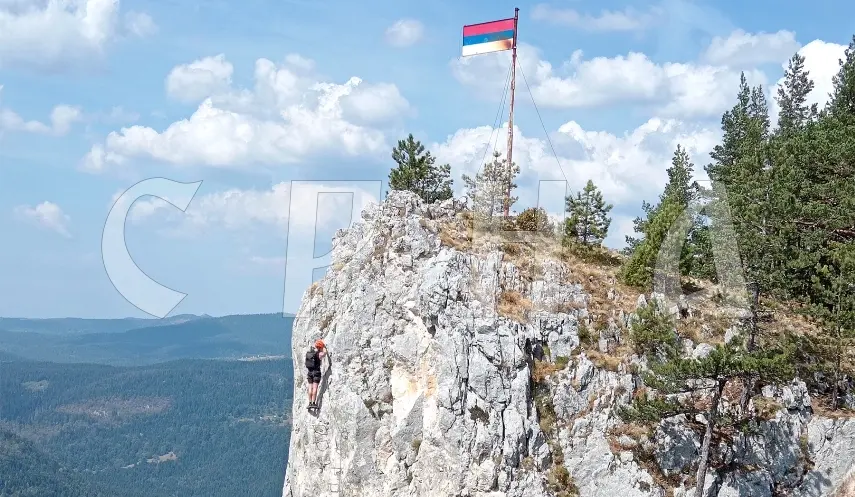ROMANIJA AND BIOŠTICA ATTRACT LOVERS OF ACTIVE HOLIDAYS IN NATURE
Republika Srpska - Sokolac - tourism /5/
09/03/2025
09:41

SOKOLAC, SEPTEMBER 3 /SRNA/ - The municipality of Sokolac attracts tourists with the adrenaline-pumping via ferrata attraction "Falcon's Path" on the Crvene Stijene /Red Rocks/ in Romanija, and one of the gems of this region is the clear mountain river Bioštica, suitable for sport fishing and kayaking.
Dragana Vukosavljević from the Sokolac Tourist Organization told SRNA that there is an idea to organize rafting in the 11-kilometer-long Bioštica Canyon on the border with the municipality of Olovo.
She pointed out that the "Falcon's Path" in Romanija, on the very edge of the Pale municipality, is visited in the summer by a large number of adrenaline sports enthusiasts, as well as interested observers, who want to see climbers climbing the 350-meter-long "iron road" as they reach the summit of Crvene Stijene.
According to her, in the last six years, several hundred cyclists from other areas have come to the Sokolac area for mountain bike rides, where about 200 kilometers of bicycle paths are in use, of which 45 kilometers are marked and arranged, organized by the Cycling Enthusiasts' Association Romanija Cycling, who did not hide their enthusiasm for the beauty of the landscape.
Vukosavljević noted that a significant role in the development of tourism and the special features it offers to domestic and foreign guests is played by the clear, fast and cold mountain river Bioštica, which springs in the Maluš forest not far from Sokolac, and whose unpolluted state is evidenced by the presence of otters and beavers in a thirty-kilometer section of the river, most of which passes through this municipality and offers the best opportunities for active recreation in nature.
"Every year, hundreds of sport fishermen from Triglav to Đevđelija gather at the Stream Fishing Cup on the Bioštica in the forested area of the village of Žunovi, some of whom stay with their families along its shores for several days," said Vukosavljević.
She emphasized that kayaking on the Bioštica is one of the attractions that is increasingly attracting lovers of active holidays in nature in the area of the Sokolac municipality.
Miroslav Divčić, a member of the Romania Outdoor Association, told SRNA that, although the kayaking season on the Bioštica is already coming to an end, this story is worthy of everyone's attention in the community because with it, the summer tourist offer of this region will be increasingly sought after and better.
He stated that the kayaking season on the river lasts only a month or two during the summer, and that a large number of people from other areas have visited this unexplored gem of the Sokolac municipality, since the first kayak descent in 2021, a length of about five kilometers, from the Bioštica spring to the Knežak spring in the village of Knežina.
"It is interesting that you pass over three waterfalls, and under an old stone mill that still offers customers flour ground on a stone wheel, as has always been done, which is a special attraction," Divčić pointed out.
He expressed his belief that kayaking is a special tourist potential that has not yet been exploited as much as it could be, and that in addition to professional people, investments should also be made in equipment, kayaks, and suits for staying in cold water in order to make this outdoor tourism offer as good as possible.
HIKE TO VELIKI LUPOGLAV
The Secretary of the Glasinac Mountaineering Society Vera Mijatović told SRNA that the mountaineers have arranged and marked a large number of hiking and cycling trails, and have invested a lot of effort, with the help of donors and the city of Istočno Sarajevo, in the construction and arrangement of the Crvene Stijene Mountaineering Lodge on Romanija, next to which is the Vjeverica /Squirrel/ Children's Adrenaline Park, which they are particularly proud of because this facility is visited by numerous guests from the region.
"What particularly pleases all mountaineers and nature lovers are the numerous facilities in Romanija, hiking and cycling trails, the via ferratas Falcon's Path and Black Bear, and the starting point is the Mountain Lodge, which has six rooms with 20 beds," said Mijatović.
She said that the Glasinac mountaineers already traditionally organize a spring hike through the Peaks of Romanija to Veliki Lupoglav /1,652 meters above sea level/ and host more than 200 mountaineers and nature lovers from Serbia and all parts of the Republika Srpska.
Guests from the region are also attracted by the Trail of Starina Novak, and two shorter circular trails that follow the movements of the hajduk bands Mali Grujica and Dijete Grujica, which were created based on traditional stories and legends about Romanija.
Members of the Glasinac Mountaineering Society also marked a circular trail that begins and ends at the Crvene Stijene Mountaineering Lodge to the recently discovered Gradić site, on a 1,396-meter-high hill in Romanija, which forms a complex surrounded by stone walls where scientific research will follow.
She noted that the society's latest activity is the development of the hiking and tourist Knežina Trail, about eight kilometers long from the Bioštica spring over the Kravarevica hill to the Monastery of the Holy Virgin, the Knežak spring and the Sultan Selim Mosque in Knežina, according to a project funded by the Tourist Organization of the City of Istočno Sarajevo.
This trail will also include the installation of two suspension bridges over the Bioštica River, which will be extremely safe and built to via ferrata standards, but also accessible to every hiker.
In Knežina, says Mijatović, there is also the famous Knežak spring with an inscription in Arabic letters, which locals claim means "A lot of water, little bread," and the Toplik thermomineral spring with an average water temperature of around 17 degrees Celsius, whose benefits have not been exploited.
NUMEROUS ARCHAEOLOGICAL SITES
Sokolac can also brag about the rich archaeological sites, and mid-August marked 600 years since the first mention of Glasinac and the church in this area, according to the Dubrovnik Archives.
The first archaeological research in Glasinac began at the end of the 19th century, and during the Austro-Hungarian Empire, 140 archaeological sites were registered in the area of the Sokolac municipality.
In 1880, along with several bronze objects, the iconic "Glasinac Cart" was found on Glasinac, the original of which is in the Natural History Museum in Vienna, and the first copy in the Sokolac municipality building.
CULTURAL-HISTORICAL HERITAGE
A special place in the recent history of the cultural and historical heritage in the Sokolac area belongs to the Serbian Military Memorial Cemetery Novi Zejtinlik, where 963 members of the Army of Republika Srpska are buried, who died on the battlefields around Sarajevo, and whose remains were transferred by their families after the signing of the Dayton Agreement in 1995.
"The tumulus and necropolis of monumental medieval tombstones in Luburić Polje are on the UNESCO World Heritage List, the necropolis with 300 monumental medieval tombstones and the foundation of a medieval church at the Crkvine site in Glasinačko Polje and the mosque in Knežina are on the List of National Monuments of BiH, while the Great Cave of Bioštica is protected as a special geomorphological reserve. The Gire Cave is a first-category natural asset, and the Podlipe Cave on Kadića Brdo is a natural monument," the Sokolac Tourist Organization said. /to be continued/

CVIJANOVIĆ: I WAS DEEPLY SHAKEN BY THE NEWS OF THE TRAGEDY DURING NEW YEAR CELEBRATIONS

TRIŠIĆ BABIĆ PRESENTS GIFT TO FIRST NEWBORN IN SRPSKA, SENDS WISHES TO FAMILY

BABY DANIJELA DAKANOVIĆ PRESENTED WITH A GOLD DUCAT



